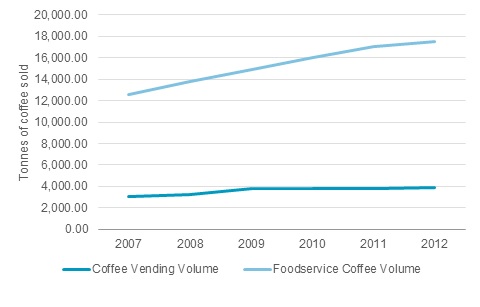
In most core markets, growth within hot drinks vending has significantly underperformed other channels of coffee and tea retail. Global retail value sales of hot drinks vending accounted for just 2% (US$2.7 billion) of the total hot drinks market in 2012, falling as a percentage of total hot drinks sales over the past decade.
Automated coffee and tea has survived largely through the low price point and on-the-go convenience of the format. Automated machines serve a quick and affordable beverage in public locations or high traffic spaces (airports or train stations) where larger cafés or kiosks are impractical or unprofitable.
The taste and quality of vended hot beverages has largely taken a back seat to convenience and price, with a failure to achieve widespread adoption by the major coffee brands that drive global growth. Is there still a place for the vended cup of coffee in today’s industry?
Specific to coffee vending of hot drinks, there are only a handful of remaining strongholds of coffee vending culture.Vending is estimated to exceed 2% of total retail coffee volumes in just four global markets: Belgium, Bulgaria, the Netherlands and South Korea.
South Korea is a particularly interesting case, because the country continues a boom in all other forms of coffee consumption. The country has experienced the fastest global growth rate among core markets in total coffee retail volume over the last five years, with similarly explosive increases in foodservice coffee consumption.
South Korean Coffee Vending Flat Lines While On-Trade Coffee Soars…
Vending of coffee, on the other hand, has not been a beneficiary of surging consumer demand for coffee in Korea. Despite a relatively mature market for coffee vending (reaching 3,900 tonnes or 5% of coffee retail volume in 2002), vending has failed to capitalize on new consumers as they migrate to coffee specialist retailers and cafés for on-the-go consumption. Koreans increasingly forego Maxwell House and other branded vending machines in office complexes and subway stations for the higher quality and price of coffee specialist retailers.
Vending in Instant Markets
Despite dwindling share, vending’s higher than usual penetration in the South Korean market – despite recent flatness - may be attributed to widespread acceptance of instant coffee in the home. Similar to markets across Asia-Pacific, instant at-home coffee consumption considerably exceeds fresh ground or whole coffee bean sales. With the retail market for instant coffee in South Korea still growing rapidly thanks to premium 2-1 and 3-1 flavour mix launches, could flavour or soluble blend innovation in vending options win consumers back? Is higher quality perception even possible in value oriented coffee vending?
While on-trade café culture and at-home brewing have undergone significant innovation and upgrades in quality, there has been little actual effort to elevate the flavour or quality of automated coffee. However, this may be changing as smaller global players turn their attention to the vending channel.
Next Generation Coffee Vending
At the University of Texas in Austin, Briggo – a US start-up - has tested automated vending of espresso based drinks on a limited basis. The company’s new vending machine (rolled out in July 2013) emphasizes the quality of its coffee sourcing and the easily replicable precision provided by automated brewing technology (consistency that a barista is sometimes unable to provide). While simple value hot drinks vending has marketed budget soluble coffee, a process as intricate and measured as espresso brewing may in fact benefit from technological automation.
It remains to be seen whether automated espresso is a scalable business concept in any market, or whether it can win acceptance with consumers that either value the café experience or are simply unwilling to pay a premium for an automated beverage. But while automated hot drinks via traditional vending dwindle in popularity, at-home automation of coffee brewing – through pod based coffee systems – has developed widespread adoption in Western Europe and fast growth in North America. Could the success of the pod beverage be transferred to a vended delivery format?
A Pod Future for Coffee Automation?
Vending offers both convenience and choice, two powerful drivers that have engineered growth in residential pod coffee machines in Western Europe and North America. Yet while vending has suffered from a poor quality perception, pod systems brands have encountered little resistance concerning coffee quality from mainstream consumers.
Keurig, the leading pod-based system manufacturer in the US, already offers a commercial vending system for offices and other captive locations as well as a portfolio of familiar coffee brands for their closed-source system. Nespresso offers a similar commercial vending product for its successful at-home coffee machine. The easily replicable quality and convenience of these systems - already a mainstay in US and European offices and enjoyed by many coffee drinkers – could be a future direction for coffee vending to explore.
Coffee vending faces a daunting perception problem to overcome, and has so far failed to win channel share in markets where soluble coffee has strong growth potential. To reinvigorate the category, next generation technology should be explored in order to increase beverage quality and win back the convenience minded consumer.
0
0









Leave a Comment
You should login or register to leave a comment
No Comments / 638 Views